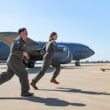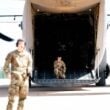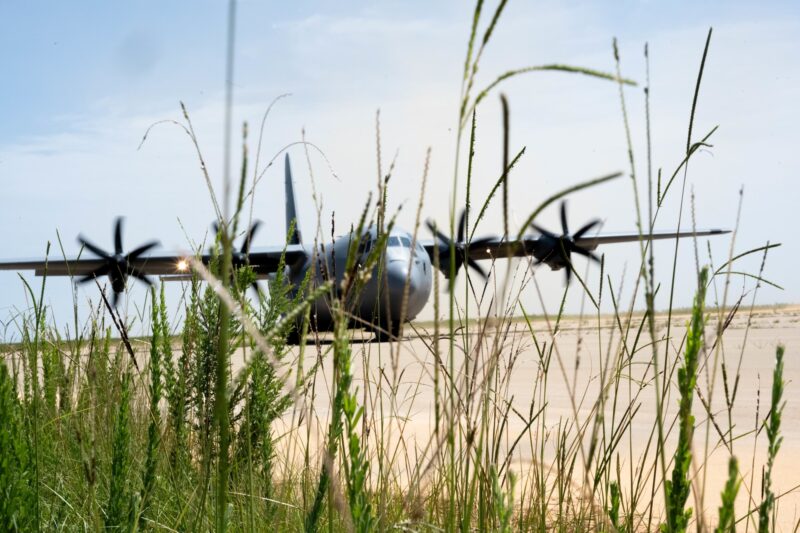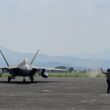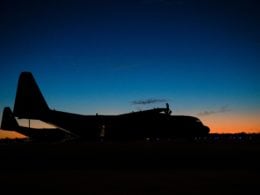POPE ARMY AIRFIELD, N.C. —
From the early morning hours to the dead of night, the sound of military aircraft and munitions can be heard at Pope Army Airfield in the surrounding area. The installation partnered with more than five other units, the Royal Canadian Air Force and the U.S. Army to execute Battalion Mass Tactical Week 24-05, Aug. 12-23, 2024.
The two-week-long exercise focuses on joint partnerships between branches delivering rapid global mobility. Planning, rallying and executing are some of the cornerstones of the philosophy of Great Power Competition.
“Battalion Mass Tactics Weeks are the premier joint training exercise between Air Mobility Command and the 82nd Airborne Division,” said Capt. Dylan Bishop, 49th Combat Training Squadron operations flight commander. “This is where we conduct Joint Forcible Entry operations to simulated near-peer threat environments. We bring a large package of mobility aircraft that drops large quantities of equipment and upward of 3,000 to 4,000 paratroopers in a one-week timeframe. The members then go on to conduct battalion level movements.”
Exercises such as these occur multiple times a year at Pope. Although not housed on a joint installation, the Airmen of Team Pope perform joint functions.
“We are the go between for the 82nd ABD and AMC,” Bishop explained. “We work hand-in-hand with our joint partners to create the most realistic and challenging training environment within the Fort Liberty Range Complex. We operate as what is called ‘White Cell.’ We are the exercise controllers, giving injects to the tactical problem set, while also ensuring there is a safe and executable plan.”
The Air Force prides itself on the capability to train members in realistic scenarios. With the months of planning that go into delivering rapid global mobility, units like the 49th CTS simulate as close to real-world training to not only develop people, but also capabilities.
Planning such an exercise can be viewed as controlled chaos. Luckily, professionals from the 49th CTS make the coordination look effortless.
“Communication and distance are some of the largest challenges we face during exercises such as these,” Bishop said. “There is a unique challenge of bringing a different package of aircraft, from both our air mobility team and our international partners, but also other major commands. We must take a very thorough look at the desired learning objectives while also focusing on the training objectives of every unit that is taking part in BMTW.”
Bishop’s section is comprised of both officer and enlisted. This structure is by design. The trust that is put into not only young officers, but a steadfast non-commissioned officer corps affords the Air Force the capability to function in a way that is unique to the U.S. Armed Forces.
“We operate as a unified force,” Bishop began. “With an officer acting as the lead planner and exercise director, our enlisted counterpart acts as the non-commissioned officer in charge, or the deputy for overall execution. Our enlisted in the 49th CTS are the absolute glue. They take their role and thrive while helping disseminate information and control the squadron level aspects of the exercise.”
Members of the 49th CTS leadership observed the execution of the exercise and the hard work put in by the Airmen under their command. Echoing the sentiments of hard work, dedication and near flawless execution, Lt. Col. Ryan Donohoe, 49th CTS commander, touted the efforts of his Airmen.
“The 49th CTS cadre of instructors and experts believe in the importance of air mobility’s role in Great Power Competition and strive to prepare our aircrew to operate under contested logistics in support of Joint and Coalition forces,” Donohoe said. “We believe that difficult training now better prepares out training audiences to excel under pressure in the future. As such, the 49th CTS strives to provide realistic and relevant training to all who come to our exercises.”
As the exercise concludes, Airmen who took part in the exercise go back to their visiting units with honed and sharpened skills — additional tools in the tool chest.
“We focus on enhancing Air Force tactical training for the visiting aircrew to enhance their capabilities for conducting joint force entry operations with joint and coalition forces. We like to use the metaphor that we build the sandbox and the exercise participants play within bounds of the sandbox we built for them,” Donohoe concluded.


